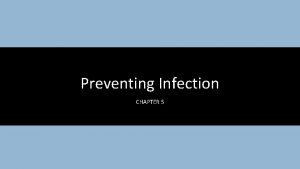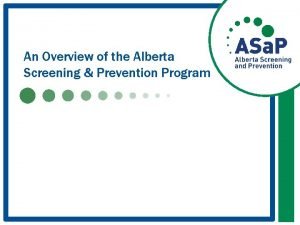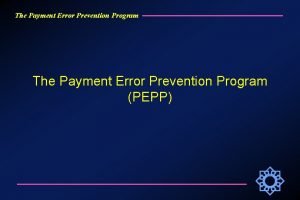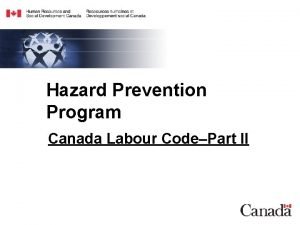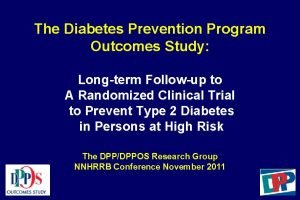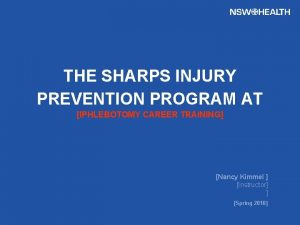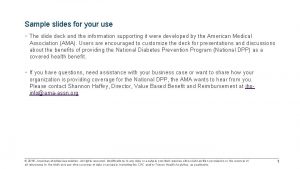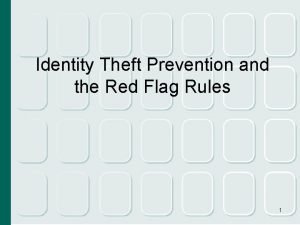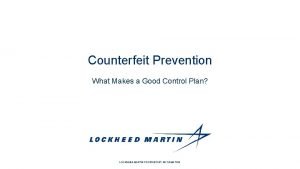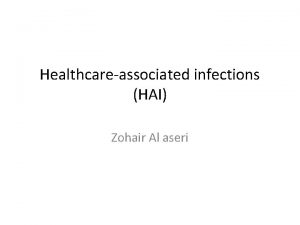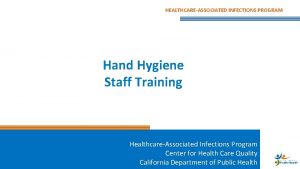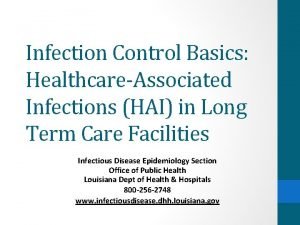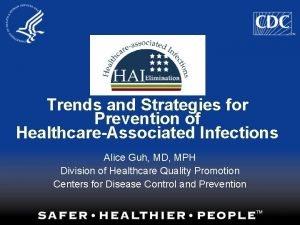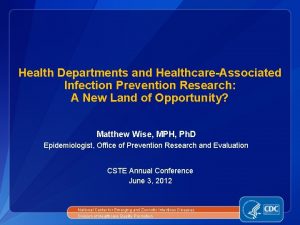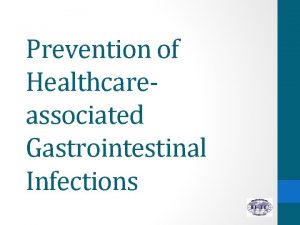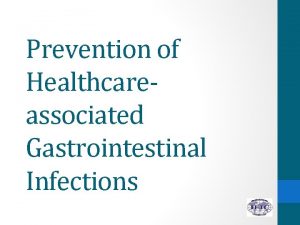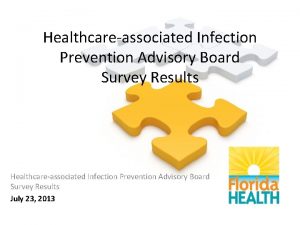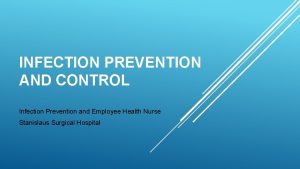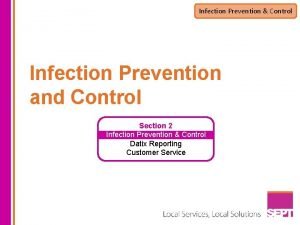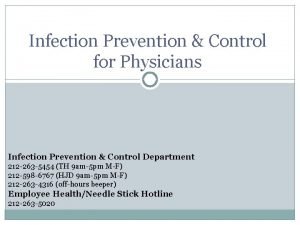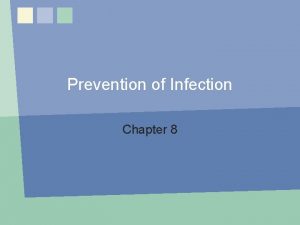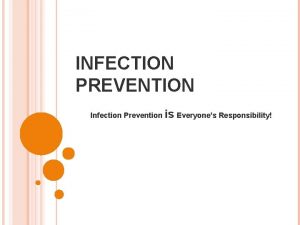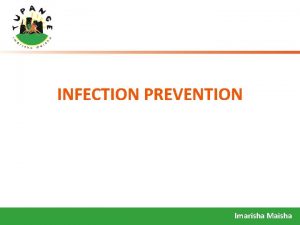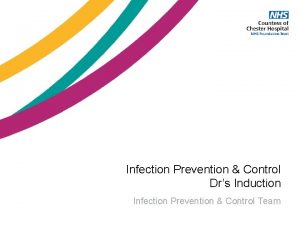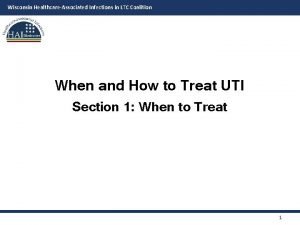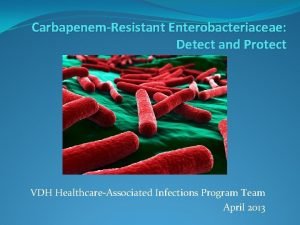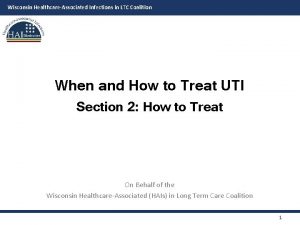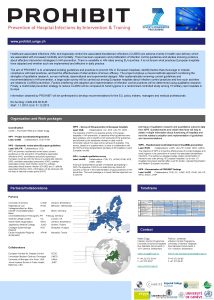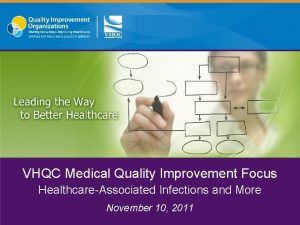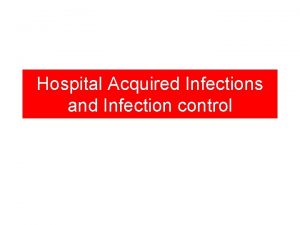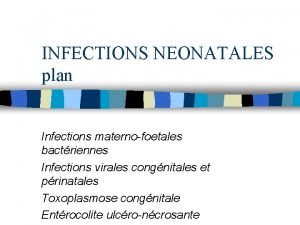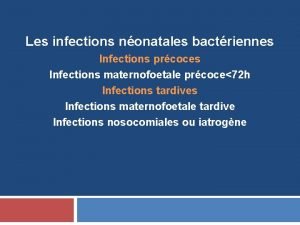HEALTHCAREASSOCIATED INFECTIONS PROGRAM Infection Prevention and the Environment




































































- Slides: 68

HEALTHCARE-ASSOCIATED INFECTIONS PROGRAM Infection Prevention and the Environment of Care in Ambulatory Surgery Centers California Ambulatory Surgery Association November 7, 2018 Vicki Keller, RN, MSN, PHN, CIC Teresa Nelson, RN, BS, CIC Healthcare-Associated Infections Program Center for Health Care Quality California Department of Public Health

HEALTHCARE-ASSOCIATED INFECTIONS PROGRAM Objectives • Review evidence-based practices known to prevent healthcare-associated infections (HAI) • Discuss the ASC environment role in surgical site infections (SSI) • Review components of the environmental assessment • Describe importance of monitoring adherence to infection prevention practices and providing feedback to ASC staff • Discuss need to report findings to Quality Program and leadership 2

HEALTHCARE-ASSOCIATED INFECTIONS PROGRAM Source of SSI Pathogens • Patient’s flora • From skin, GI tract, mucous membranes • Due to inadequate skip prep • Seeding from pre-existing sites of infection • Surgical personnel flora • Inadequate hand hygiene • Breaks in aseptic techniques • Contaminated equipment • Surgical instruments • Medical devices in operating room • Ventilation 3

HEALTHCARE-ASSOCIATED INFECTIONS PROGRAM HAI / SSI Prevention – What works? • Evidence-based practice recommendations are based on science • If studied systematically, does a practice result in reduced infection rates? • To be considered an infection prevention “best practice, ” the practice should be associated with sustained low HAI rates • Recommended practices based on careful, systematic evaluation of available studies, including risk/benefit • Where scientifically valid studies are lacking, consensus expert opinion also considered but never alone 4

HEALTHCARE-ASSOCIATED INFECTIONS PROGRAM HAI / SSI Prevention – What works? • Best sources for evidence-based SSI prevention practice recommendations • Centers for Disease Control and Prevention (CDC) • Healthcare Infection Control Practices Advisory Committee (HICPAC) - includes surgeon members • Infectious Diseases Society of America (IDSA) / Society for Healthcare Epidemiology of America (SHEA) 5

HEALTHCARE-ASSOCIATED INFECTIONS PROGRAM Preventing SSI: The MOST Important Things Prevent the Devastating Effects of Deep/Organ Space SSI q Prophylactic antibiotics Right drug, right dose, right time q No doses after incision closed q Alcohol-based skin prep q Blood glucose control, all patients q Normothermia, all patients q Increased Fi 02, if normal function q Pre-night shower or bath q Treat other infections q Smoking cessation at least 30 days q No hair removal; if must, clippers q Maintain positive pressure ventilation q Hand hygiene q Surgical attire worn entire time including mask and head cover (covering all head and facial hair) q Clean and disinfect all surfaces between cases q Flash sterilization only if emergency q Sterile dressing for 24 -48 hours CDC Guideline for the Prevention of Surgical Site Infection, 2017 6

HEALTHCARE-ASSOCIATED INFECTIONS PROGRAM Core Infection Prevention Practices For Use in All Health Care Settings at All Times q Visible, tangible leadership support for infection control q Infection prevention training for all HCP q Patient, family, caregiver HAI prevention education q Performance monitoring and feedback q Early, prompt removal of invasive devices q Occupational health q Standard precautions q Hand hygiene q Environmental cleaning and disinfection q Injection safety, medication safety q Assess risk, use PPE appropriately q Minimize potential exposures q Clean and reprocess reusable medical equipment q Transmission-based precautions as necessary cdc. gov/hicpac/recommendations/core-practices. html 7

HEALTHCARE-ASSOCIATED INFECTIONS PROGRAM Perform Adherence Monitoring for Evidencebased HAI / SSI Prevention Practices CDPH adherence monitoring tools include • OR observations • Hand hygiene • Safe injection practices • Environmental cleaning and disinfection • Device reprocessing • High level disinfection of reusable devices • Sterilization of reusable devices https: //www. cdph. ca. gov/Programs 8

HEALTHCARE-ASSOCIATED INFECTIONS PROGRAM Care of the ASC Environment for Preventing Infections 9

HEALTHCARE-ASSOCIATED INFECTIONS PROGRAM Perioperative Environmental Factors in Disease Transmission and SSI • Operating room cleanliness/clutter • Operating room staff and patient traffic patterns • Operating room and sterile processing air flow, temperature, and humidity • Safe handling of medical waste • Disinfection of point of care testing equipment • Water intrusion/managing mold • Staff attire • Hand hygiene CDC/HICPAC (2003) • Instrument processing CDC(2017) CDC/HICPAC (2017 10

HEALTHCARE-ASSOCIATED INFECTIONS PROGRAM 11 How a Contaminated Environmental Surface Leads to Patient Infection 1. Surface becomes contaminated with a pathogen by direct contact or droplets 2. Organism able to survive on the surface 3. Surface touched by another person who picks up sufficient inoculum 4. Person omits or poorly performs hand hygiene 5. Person transmits the pathogen to another person or object in sufficient quantity to cause colonization or infection Jarvis (2015) APIC Text (2014)

HEALTHCARE-ASSOCIATED INFECTIONS PROGRAM 12 Maintaining a Sanitary Environment • ASC must provide a clean and sanitary environment including • Waiting areas • Pre-surgical prep area • Post-anesthesia care unit (PACU) • Operating room • Instrument and equipment reprocessing area • Floors • Horizontal surfaces • Air inlets and ventilation ducts • Patient equipment • Mechanical rooms, supply, storage areas APIC Text (2014)

HEALTHCARE-ASSOCIATED INFECTIONS PROGRAM Clean Before Disinfection A surface must be thoroughly cleaned before it can be disinfected! • Cleaning reduces microorganisms from a surface that interfere with disinfection • Disinfectants are not as effective in the presence of organic material HICPAC /CDC 2003, 2017 HICPAC /CDC 2008 13

HEALTHCARE-ASSOCIATED INFECTIONS PROGRAM Proper Use of Cleaning Supplies • Ensure cleaning equipment and supplies are clean • Ensure staff know how to use cleaning and disinfecting products AORN (2018) 14

HEALTHCARE-ASSOCIATED INFECTIONS PROGRAM 15 Detergents and Disinfectants • Detergent • Used for cleaning • Contains surfactants; lifts dirt • Can become easily contaminated, does not kill microorganisms • Less toxic, generally less odor, less costly than disinfectant • Disinfectant • Inhibit growth or kill microorganisms • More toxic, more costly than detergent HICPAC /CDC 2003, 2017

HEALTHCARE-ASSOCIATED INFECTIONS PROGRAM 16 EPA Label Claim for Disinfectant • The EPA label claim states if the product is • Virucidal • Bactericidal • Tuberculocidal • Fungicidal • Sporicidal • Clarifies manufacturer’s instructions for use, including wet contact time required to achieve the desired degree of microbial killing CDC (2017)

HEALTHCARE-ASSOCIATED INFECTIONS PROGRAM Importance of Wet Contact Time • Wet contact time is the time required for a disinfectant to kill microorganisms on a pre-cleaned surface • Surface must remain wet long enough to achieve the claimed level of disinfection • Follow manufacturer’s guidelines CDC (2017) 17

HEALTHCARE-ASSOCIATED INFECTIONS PROGRAM Selection of Disinfectant Consider • Nature of the item to be disinfected • Amount of organic soil present • Number of microorganisms present • Innate resistance of microorganisms to the inactivating effects of the disinfectant • Type and concentration of disinfectant • Duration of disinfectant contact time • Other specific indications and directions for use HICPAC /CDC 2003 18

HEALTHCARE-ASSOCIATED INFECTIONS PROGRAM 19 Disinfectant Quaternary Ammonium Products (Quats) Phenolics Chlorine-based Strengths • Widely used • Bactericidal, fungicidal, virucidal • Hospital-grade quats tuberculocidal • Safe for computer keyboards • Bactericidal, virucidal, fungicidal, • • • tuberculocidal Not sporicidal Broad antimicrobial activity Does not leave toxic residues Inexpensive Fast acting Removes dried organisms, biofilms Hydrogen peroxide, • Effective • Bactericidal, virucidal at 30 - 60 sec Accelerated H 2 O 2 • Fungicidal at 10 min • Low EPA toxicity rating Concerns • Hard water can reduce effectiveness • Generally not sporicidal • Occupational asthma documented Absorbed by porous materials Can irritate tissue Unsafe for use in nurseries Can cause eye irritation, gastric burns Inactivated by organic matter Discolors fabrics Wet contact time 10 minutes Corrosive in high concentrations Can release toxic chlorine gas when mixed with ammonia • Expensive • • •

HEALTHCARE-ASSOCIATED INFECTIONS PROGRAM Why Bleach for Clostridium difficile? • C. difficile spores are difficult to kill and adhere to environmental surfaces for extended periods • Use of a 1: 10 dilution of bleach (500 ppm) for cleaning • Reduces surface contamination • Instrumental in outbreak control • Alternatives to bleach also available. For EPA-approved disinfectants with label claims for killing C. difficile spores, see http: //www. epa. gov/oppad 001/chemregindex. htm CDC(2003) CDC/HICPAC (2008) 20

HEALTHCARE-ASSOCIATED INFECTIONS PROGRAM 21 Suggested Processes for Cleaning and Disinfection

HEALTHCARE-ASSOCIATED INFECTIONS PROGRAM Damp Dusting • Removes dust from horizontal surfaces • Damp dust first thing in the morning before additional items or equipment are brought into the room • Use a clean, low linting cloth moistened with disinfectant • Damp dust from top to bottom AORN (2018) 22

HEALTHCARE-ASSOCIATED INFECTIONS PROGRAM Turnover Cleaning and Disinfection • Clean and disinfect between cases • Clean and disinfect patient areas after each patient • Prioritize high-touch objects and equipment • Contamination frequently touched items can lead to contaminated health care personnel hands AORN (2018)

HEALTHCARE-ASSOCIATED INFECTIONS PROGRAM Terminal Cleaning and Disinfection • Perform every day when the room has been used • Clean and disinfect all exposed surfaces of all equipment, including wheels and casters, at the end of the day • Clean and disinfect the floor with a wet vacuum or single-use mop • Move equipment around the room to clean the floor underneath AORN (2018)

HEALTHCARE-ASSOCIATED INFECTIONS PROGRAM Clean Using a Systematic Approach 1. Ensure proper hand hygiene and use of gloves 2. Focus on frequently touched surfaces 3. Work from clean-to-dirty and high-to-low areas 4. Work from room periphery toward the OR bed 5. Avoid generating aerosols 6. Change cleaning cloths AORN(2018) 25

HEALTHCARE-ASSOCIATED INFECTIONS PROGRAM Cleaning Schedule • Areas and equipment that are not terminally cleaned daily must be cleaned according to your facility’s schedule (weekly or monthly) • ventilation ducts • clean and soiled utility rooms • sterile storage areas • sterilizers • lounges • refrigerators • Follow your facility’s specific cleaning schedule • Document cleaning on your facility’s cleaning log

HEALTHCARE-ASSOCIATED INFECTIONS PROGRAM Cleaning Responsibility • Write a policy designating “who cleans what and when” • Create a check list to avoid missing any surface/equipment • Establish a training program with return demonstration upon hire and annually • Orient all personnel to proper cleaning methods • Perform adherence monitoring or cleaning practices • Provide feedback of adherence monitoring to staff 27

HEALTHCARE-ASSOCIATED INFECTIONS PROGRAM High Touch Surfaces for Cleaning Checklist (Examples) Pre-op/Post op q Gurney side rails q Call bell q Light switches q Doorknobs q TV remote q IV pump q IV poles q Computer keyboard q Telephone q Over bed table q Respiratory and other bedside equipment q Chairs OR and Endoscopy Suites q Light switches q Doorknobs q OR table and pad q OR table straps and attachments q Positioning devices q Mayo stands and back tables q Anesthesia machine and controls q BP cuffs and tubing q Cables and cords q Chairs stools q Video device controls q Supply carts and handles 28

HEALTHCARE-ASSOCIATED INFECTIONS PROGRAM Room Turn-Over Cleaning Suggestions • Use check list of surfaces to be cleaned and disinfected • Consider organizing the room into zones • One zone for each part of the room • Assign staff to clean and disinfect a given zone • Consider organizing the room turn over into teams • One team cleaning the periphery • Another team clean the procedure table and the heavily contaminated surfaces • Define responsibility and frequency for cleaning and disinfecting equipment and surfaces • Include pre-post op areas, lounges, sterile processing and de-contamination areas 29

HEALTHCARE-ASSOCIATED INFECTIONS PROGRAM Floor Cleaning • Clean and disinfect the floor surfaces at the • edge of the room first • moving toward the center of the room • The center of the room is where most patient care happens • the center is likely to be dirtier AORN (2018)

HEALTHCARE-ASSOCIATED INFECTIONS PROGRAM Privacy Curtains • Bacteria and fungi can survive on polyester, cotton, wool, and other fabrics • Privacy curtains are considered high-touch surfaces • Can become rapidly contaminated • Hands can become contaminated after handling curtains • Study found 50% of hands contaminated after handling curtains Ohl et. al. (2012) https: //www. inspq. qc. ca/pdf/publications/1729_Notice. Recomm. CINQ_ Divid. Curtains. Infect. Risk. pdf 31

HEALTHCARE-ASSOCIATED INFECTIONS PROGRAM Cleaning Porous Surfaces • Fabric • Vacuum regularly and re-cover when worn • Organic material and excess liquid should be extracted as much as possible • Carpets • Steam cleaning is recommended for as appropriate • Allow to dry for 72 hours to prevent growth of fungi • No epidemiological evidence to show that pathogens found on fabric are linked to increased risk of HAIs CDC/HICPAC (2003) APIC Text (2014) 32

HEALTHCARE-ASSOCIATED INFECTIONS PROGRAM Rusted, Worn, or Damaged Equipment • Surfaces must be intact to be cleaned before they can be disinfected. Discard or repair: • Rusted metal • Torn mattress pad • Cracked positioning wedges • Chipped paint/coating • Chipped counter covering (laminates) 33

HEALTHCARE-ASSOCIATED INFECTIONS PROGRAM 34 Whole-Room Disinfection Technologies

HEALTHCARE-ASSOCIATED INFECTIONS PROGRAM 35 Whole-Room Disinfection Technologies • Developed because adequacy of manual cleaning and disinfection is often suboptimal • e. g. , wet contact time is not always achieved • “Touchless” or non-manual techniques can provide a higher level of disinfection or decontamination • Types include • Hydrogen peroxide fogging (dry mist or vapor) • Ultraviolet light (continuous emitting or pulsed xenon. UV) http: //www. cadth. ca/sites/default/files/pdf/htis/nov 2014/RC 0545%20 Room%20 Disinfection%20 Final. pdf

HEALTHCARE-ASSOCIATED INFECTIONS PROGRAM Caveats to Whole-Room Disinfection Technologies • Whole room disinfection technologies cannot substitute for: • Good physical cleaning practices • High level compliance to hand hygiene • Avoidance of cross-contamination • Staff education and competencies • The need to assess cleaning procedures, chemicals used, safety issues 36

HEALTHCARE-ASSOCIATED INFECTIONS PROGRAM 37 Monitoring the Thoroughness of Cleaning

HEALTHCARE-ASSOCIATED INFECTIONS PROGRAM 38 Monitoring Effective Cleaning • Confirmed visually – appears clean or finger-swipe clean • Fast and inexpensive, but lacks objectivity • Confirmed via technology • Increasingly becoming the community standard Florescence Adenosine Triphosphate (ATP) Environmentally stable marker is visible to UV light if still present after cleaning Measures residual organic matter left on a surface after cleaning http: //www. cdc. gov/hai/toolkits/Evaluating-Environmental-Cleaning. html Lillis. ATP Testing: A Proven Method to Measure Cleanliness. 2015

HEALTHCARE-ASSOCIATED INFECTIONS PROGRAM Are Environmental Cleaning Prevention Practices Performed Routinely in ASCs? Results of CDPH HAI Program Liaison IP Observations 39

HEALTHCARE-ASSOCIATED INFECTIONS PROGRAM 40 Environmental Cleaning and Disinfection Adherence Monitoring 2016 - 2018 ASC Environmental Cleaning Adherence Percentages (n=46 ASC) Successful Missesd 120 # Observations 100 80 60 40 20 0 98% 88% 99% 36% 56% Detergent/ Wet contact time New clean cloth Checklist of high High touch disinfection according to used in each touch surfaces solution mixed, manufacturer patient area used thoroughly stored according cleaned/ to manufacturer disinfected after each patient

HEALTHCARE-ASSOCIATED INFECTIONS PROGRAM Environmental Cleaning Adherence Monitoring in the Perioperative Area https: //www. cdph. ca. gov/Programs 41

HEALTHCARE-ASSOCIATED INFECTIONS PROGRAM Point of Care Testing Outbreaks have been reported related to sharing blood glucose monitors • Perform hand hygiene before and after procedure • Clean and disinfect blood glucose monitors • After every patient use • Follow manufacture’s recommendations • Use EPA approved disinfectant • Use finger stick devices for only one patient • Do not share insulin pens between patients 42

HEALTHCARE-ASSOCIATED INFECTIONS PROGRAM Point of Care Testing Adherence Monitoring 30 25 2016 -2018 ASC Point of Care Testing Adherence Percentages (n=46 ASC) Successful Missesd # Observations 20 15 10 5 0 Hand hygiene Gloves worn. Finger stick Blood glucose Insulin pen before Hand hygiene device for only meter cleaned used on only procedure after removal 1 patient to 1 patient manufacturer 43

HEALTHCARE-ASSOCIATED INFECTIONS PROGRAM Blood Glucose Adherence Monitoring Tool 44

HEALTHCARE-ASSOCIATED INFECTIONS PROGRAM 45 Temperature, Humidity, and Ventilation

HEALTHCARE-ASSOCIATED INFECTIONS PROGRAM Infection Control Impact of HVAC System Maintenance and Repair • A failure or malfunction of any component of the HVAC system may subject patients and staff to discomfort and exposure to airborne contaminants • Only limited information is available from formal studies on the infection-control implications of a complete air-handling system failure or shutdown for maintenance • Most experience has been derived from infectious disease outbreaks and adverse outcomes among high-risk patients when HVAC systems are poorly maintained 46

HEALTHCARE-ASSOCIATED INFECTIONS PROGRAM HVAC Systems and HAIs • The rates at which particles settle are a function of their size, shape, density, and air movement • Turbulence within a room increases the residence time of larger particles in the air, hence the desire for laminar airflows in operating rooms • Traffic control reduces disruption of air flow • The viability of microorganisms embedded in water droplets (aerosols) is affected by temperature, humidity, and air velocity 47

HEALTHCARE-ASSOCIATED INFECTIONS PROGRAM Environmental Factors Regulated to Reduce OR Contamination Air Change Rate/ Dilution Filtration Humidity Temperature • Affects humidity and personnel comfort, patient risk of SSI • Air movement and pressurization • Positive • • 48

HEALTHCARE-ASSOCIATED INFECTIONS PROGRAM Air Exchange Rate • Increasing the dilution rate of clean air into a space reduces the exposure time of microorganisms generated within the room by objects, staff, or the patient 49

HEALTHCARE-ASSOCIATED INFECTIONS PROGRAM ANSI/ ASHRAE/ASHE Standard 170 Ventilation Specifications 50

HEALTHCARE-ASSOCIATED INFECTIONS PROGRAM High Humidity and Pathogens • Survival of viruses and other infectious agents may depend partly on levels of relative humidity (RH) • Airborne fungi may be related to RH, particularly if room RH exceeds 70% for long periods • A maximum room RH of 60% generally provides acceptable comfort conditions for human occupancy and minimizes the risk of mold growth CDC/HICPAC (2003) 51

HEALTHCARE-ASSOCIATED INFECTIONS PROGRAM 52 Low Humidity • Some products are very sensitive to low humidity • Biological and chemical indicators • EKG electrodes • May affect the operation of some electro-medical equipment, particularly with older model electro-medical equipment • Equipment may malfunction unexpectedly • Low humidity levels may also impact calibration • In low humidity, a person may become more easily “charged” and receive an electrostatic shock when coming in contact with medical equipment – FIRE HAZARD https: //www. aorn. org/-/media/aorn/guidelines/position-statements/posstatendorsed-relative-humidity-joint-communicaiton. pdf

HEALTHCARE-ASSOCIATED INFECTIONS PROGRAM 53 Positive Air Pressure • Air moves out of the room • Includes: operating rooms, C-section suites, protective environments (e. g. , bone marrow transplant unit) CDC/HICPAC (2003)

HEALTHCARE-ASSOCIATED INFECTIONS PROGRAM 54 Negative Air Pressure • Air moves into the room • Includes: airborne infectious isolation rooms (AIIR), areas where coughing may be induced (e. g. , bronchoscopy suite, endoscopy suite, decontamination room, sputum induction room) CDC/HICPAC ((2003)

HEALTHCARE-ASSOCIATED INFECTIONS PROGRAM 55 Performing an Environmental Assessment

HEALTHCARE-ASSOCIATED INFECTIONS PROGRAM Environmental Assessment • Opportunity for multidisciplinary, multifunctional, multipurpose inspection areas: • Life safety (fire and evacuation plans) • Patient safety (injection safety, fall risks, medication safety) • Utility management (HVAC, water quality, water intrusion, medical waste management) • Team rounding at regular intervals is recommended • Include outside contracted environmental services and building maintenance staff 56

HEALTHCARE-ASSOCIATED INFECTIONS PROGRAM Environmental Assessment - Sharps containers • Place appropriately (i. e. , not too high, not directly under glove box or electrical outlet) • Secure • Change when ¾ full • Replace regularly • User friendly • Safety devices accessed prior to disposal 57

HEALTHCARE-ASSOCIATED INFECTIONS PROGRAM Water Systems • Stagnant water allows formation of biofilms • Contain fungi, gram-negative bacteria, legionella, other organisms • Infrequently used fixtures are more prone • Flush and clean sinks, eyewash stations, ice machines regularly • Do not use tap water to rinse semi-critical devices after disinfection • Remove aerators from faucets • Avoid decorative fountains/ waterfalls 58

HEALTHCARE-ASSOCIATED INFECTIONS PROGRAM 59 Water Intrusion / Flood Response Policies and procedures should • Define roles of multidisciplinary response team • Environmental services • Maintenance/engineering • Construction company • Consulting disciplines • Infection prevention • Safety • Define what constitutes a flood • Document mitigation of water damaged walls/cabinets/supplies or equipment

HEALTHCARE-ASSOCIATED INFECTIONS PROGRAM 60 Medical Biohazardous Waste • Contain in covered, leak-proof container with biohazard symbol • Store separately from other waste, in red bags • May contain sharps containers, pharmaceutical waste, and pathology waste • Store on-site for no longer than 7 days if < 20 pounds • Store on-site for no longer than 30 days if > 20 pounds • Ensure signage on rooms where biohazardous materials are contained or stored https: //www. cdph. ca. gov/Programs/CEH/DRSEM/CDPH%20 Document%20 Library /EMB/Medical. Waste. Management. Act. pdf

HEALTHCARE-ASSOCIATED INFECTIONS PROGRAM Hand Hygiene Areas • Adequate in number and evidence of use • Adequate soap, paper towels, trash cans • Alcohol hand rub at or near appropriate room entrances and in patient rooms • Placement of alcohol-based hand rubs dispensers in compliance with fire code 61

HEALTHCARE-ASSOCIATED INFECTIONS PROGRAM Effective ASC Infection Prevention – Putting It All Together 62

HEALTHCARE-ASSOCIATED INFECTIONS PROGRAM Perform Adherence Monitoring • Provide “just in time” education when a breach is identified • Provide feedback of adherence monitoring results at staff meetings • Identify gaps in infection prevention activities, as a team, that may lead to HAI • Assign different team members to perform periodic adherence monitoring to raise awareness of gaps 63

HEALTHCARE-ASSOCIATED INFECTIONS PROGRAM Quality and Safety Programs • Present safety rounds and adherence monitoring results regularly to your Quality Program and leadership team • Submit documentation of HVAC maintenance and repair for review • Include gaps in adherence monitoring and safety rounds in your risk assessment and annual plan Quality 64

HEALTHCARE-ASSOCIATED INFECTIONS PROGRAM 65 Summary • A properly cleaned and disinfected patient care environment is essential to prevent HAI • A surface must be physically cleaned before it can be disinfected • Environmental HVAC systems play an important role in SSI prevention • Monitoring adherence of infection prevention practices with feedback of results to staff can improve adherence • Documenting and reporting multidisciplinary environmental assessments and adherence monitoring results are important aspects of ASC Quality and Safety programs

HEALTHCARE-ASSOCIATED INFECTIONS PROGRAM 66 References AORN Recommendations on Environmental Cleaning, https: //www. aorn. org/search#q=environmental%20 cleaning APIC Text (2014), http: //text. apic. org/toc/infection-prevention-for-practice-settings-andservice-specific-patient-care-areas/ambulatory-surgery-centers APIC Text (2014), http: //text. apic. org/toc/infection-prevention-for-support-services-andthe-care-environment/environmental-services ASHRAE: HVAC Design Manual for Hospitals and Clinics Second Edition (2013) http: //wtgzik. pairserver. com/Transfer/ASHRAE_HVAC-Hospital. Book_WHOLEBOOK_PRF_2 -12 -13 -wg. pdf CDC – Guideline for disinfection and sterilization in healthcare facilities (2017). https: //www. cdc. gov/infectioncontrol/guidelines/disinfection/ CDC/HICPAC – Core infection prevention and control practices for safe healthcare delivery in all settings – recommendations of the healthcare infection control practices advisory committee (2017). https: //www. cdc. gov/hicpac/pdf/core-practices. pdf

HEALTHCARE-ASSOCIATED INFECTIONS PROGRAM References CDC/HICPAC - Guideline for environmental infection control in health-care facilities (2003, updated 2017) https: //www. cdc. gov/infectioncontrol/pdf/guidelines/environmentalguidelines. pdf CDC/HICPAC – Guideline for prevention of surgical site infections (2017). https: //jamanetwork. com/journals/jamasurgery/fullarticle CDPH – Monitoring adherence to health care practices that prevent infection (2017). https: //www. cdph. ca. gov/Programs/CHCQ/HAI/Pages/Monitoring. Adherence. To. H CPractices. That. Pr CDC/HICPAC - Guideline for Disinfection and Sterilization in Healthcare Facilities, (2008) Jarvis, W. The inanimate environment, Bennnett & Brachman’s Hospital Infections, 6 th ed (2015) Ohl, M. , Schweizer, M. , Graham, M. , Heilmann, K. , Boyken, L. , Diekema, D. , Hospital privacy curtains are frequently and rapidly contaminated with potentially pathogenic bacteria. AJIC (2012) 67

HEALTHCARE-ASSOCIATED INFECTIONS PROGRAM Questions? For more information, please contact any HAI Liaison IP Team member. Or email HAIProgram@cdph. ca. gov 68
 Primary prevention secondary prevention tertiary prevention
Primary prevention secondary prevention tertiary prevention Puncture resistant container
Puncture resistant container Chapter 19 disease transmission and infection prevention
Chapter 19 disease transmission and infection prevention Chapter 19 disease transmission and infection prevention
Chapter 19 disease transmission and infection prevention Chapter 16 infection prevention and control
Chapter 16 infection prevention and control Define infection prevention chapter 5
Define infection prevention chapter 5 Chapter 25 sexually transmitted infections and hiv/aids
Chapter 25 sexually transmitted infections and hiv/aids Johnson and johnson botnet infections
Johnson and johnson botnet infections Bone and joint infections
Bone and joint infections Methotrexate and yeast infections
Methotrexate and yeast infections Retroviruses and opportunistic infections
Retroviruses and opportunistic infections Opportunistic infections
Opportunistic infections Opportunistic infections
Opportunistic infections Storch infections
Storch infections Storch infections
Storch infections Neurosiphyllis
Neurosiphyllis Bacterial vaginosis
Bacterial vaginosis Postpartum infections
Postpartum infections Genital infections
Genital infections Amber blumling
Amber blumling Nosocomial infections
Nosocomial infections Acute gingival infections
Acute gingival infections Alberta screening and prevention program
Alberta screening and prevention program Financial environment of business
Financial environment of business Payment error prevention program
Payment error prevention program Kshousingcorp/eviction-prevention-program
Kshousingcorp/eviction-prevention-program Hazard prevention program
Hazard prevention program Diabetes prevention program outcomes study
Diabetes prevention program outcomes study Sharps injury prevention program
Sharps injury prevention program Diabetes prevention program ppt
Diabetes prevention program ppt Identity theft prevention program
Identity theft prevention program Counterfeit parts prevention program as5553
Counterfeit parts prevention program as5553 Chapter 16 infection control and standard precautions
Chapter 16 infection control and standard precautions Cosmetology infection control
Cosmetology infection control Certification board of infection control and epidemiology
Certification board of infection control and epidemiology Hát kết hợp bộ gõ cơ thể
Hát kết hợp bộ gõ cơ thể Bổ thể
Bổ thể Tỉ lệ cơ thể trẻ em
Tỉ lệ cơ thể trẻ em Voi kéo gỗ như thế nào
Voi kéo gỗ như thế nào Thang điểm glasgow
Thang điểm glasgow Bài hát chúa yêu trần thế alleluia
Bài hát chúa yêu trần thế alleluia Môn thể thao bắt đầu bằng chữ đua
Môn thể thao bắt đầu bằng chữ đua Thế nào là hệ số cao nhất
Thế nào là hệ số cao nhất Các châu lục và đại dương trên thế giới
Các châu lục và đại dương trên thế giới Công thức tiính động năng
Công thức tiính động năng Trời xanh đây là của chúng ta thể thơ
Trời xanh đây là của chúng ta thể thơ Cách giải mật thư tọa độ
Cách giải mật thư tọa độ Phép trừ bù
Phép trừ bù Phản ứng thế ankan
Phản ứng thế ankan Các châu lục và đại dương trên thế giới
Các châu lục và đại dương trên thế giới Thể thơ truyền thống
Thể thơ truyền thống Quá trình desamine hóa có thể tạo ra
Quá trình desamine hóa có thể tạo ra Một số thể thơ truyền thống
Một số thể thơ truyền thống Cái miệng nó xinh thế chỉ nói điều hay thôi
Cái miệng nó xinh thế chỉ nói điều hay thôi Vẽ hình chiếu vuông góc của vật thể sau
Vẽ hình chiếu vuông góc của vật thể sau Thế nào là sự mỏi cơ
Thế nào là sự mỏi cơ đặc điểm cơ thể của người tối cổ
đặc điểm cơ thể của người tối cổ Thế nào là giọng cùng tên?
Thế nào là giọng cùng tên? Vẽ hình chiếu đứng bằng cạnh của vật thể
Vẽ hình chiếu đứng bằng cạnh của vật thể Phối cảnh
Phối cảnh Thẻ vin
Thẻ vin đại từ thay thế
đại từ thay thế điện thế nghỉ
điện thế nghỉ Tư thế ngồi viết
Tư thế ngồi viết Diễn thế sinh thái là
Diễn thế sinh thái là Dạng đột biến một nhiễm là
Dạng đột biến một nhiễm là Bảng số nguyên tố lớn hơn 1000
Bảng số nguyên tố lớn hơn 1000 Tư thế ngồi viết
Tư thế ngồi viết





